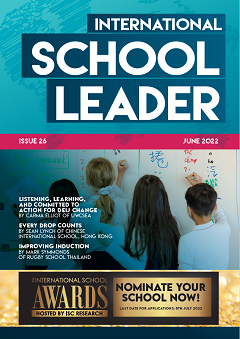By Christopher Allen
The recent ISC Research report The International School Student Profile highlights the rapidly changing landscape of international schools. In the past two decades, there has been a shift away from international schools being predominantly attended by expat, ‘third-culture’ kids to being increasingly made up of national students. Take my school in Muscat, Oman, Al Sahwa, a national school with an international curriculum (IB) and a mix of expat and national staff. Increasingly national families in our major world cities want an international curriculum and a big part of that philosophically is the concept of international mindedness (IM).
What is IM?
The phrase ‘international mindedness’ has become inextricably linked to the International Baccalaureate. The IB defines the practice of IM in three concepts: multilingualism, intercultural understanding and global engagement. In reality, IM is a fuzzy phrase that is hard to pin down and even harder to bottle.
In your context, you may use a different phrase: global citizenship, internationalism or interculturalism – all similar yet with slightly different emphasises. Linking these terms is a pedagogical concept of a posture of teaching students to face outwards towards an interconnected and interdependent global village. My own definition of IM over the years has boiled down to simply learning to be a global neighbour.
Having worked in two IB schools of national students in the Middle East, I have become fascinated by the challenge of engaging with IM in a meaningful manner to shape school culture. Why and how do you teach IM in an international school with a culturally homogeneous student body?
From this question, I conducted some primary research (structured interviews and questionnaires) with teachers in Oman into IM. Two findings became clear. All interviewees felt strongly that IM is important and should be explicitly taught in schools. However, each teacher had a different definition and rationale for IM. When asked “Why is IM important?”, some suggested it was needed to develop tolerance and open-mindedness. Others explained that IM is important for students’ future studies, opening access to a ‘Western university’ and improving future earning potential. Such honest reflections beg the question: is IM egotistical or altruistic? Is this a form of human capital theory in education, or is it really about what Ian Hill (former IBO Deputy Director General) defines as education of “peaceful co-existence and global sustainable development for the future of the human race”?
The first IB IM core concept of multilingualism, in my experience, is less relevant, and was replaced by bilingualism in most international schools. Intercultural understanding is present, but from my research, the concept of global engagement was more often attached to IM by teachers. Global engagement can best be developed through IM causes that are global in nature yet local in impact; I call these ‘glocal’ causes.
Glocal causes
What do I mean by glocal? Glocal is an issue that cuts across borders between local and global and can become a focus across your school’s written and hidden curriculum. This is an issue that humanity needs to face, be supra-national in nature, and essential for students to engage with. It could be climate change, human trafficking or cybersecurity to name just a few.
The 17 United Nations Sustainable Development Goals are a good starting point. I’m sure you can find that a few of these goals have a glocal impact that your students can easily engage with. One example I have was with some grade 8 students on a community project. These Omani students had discovered the global issues of poverty and migration in our city and wanted to reach out to help local South Asian labourers. These labourers were working just outside our school gates. The students decided to develop their own small-scale food distribution network to meet the very real needs.
What cause can your school adopt? Which glocal cause is on your doorstep?
How do you measure IM?
Can you assess IM? If a student gets 45 on their IB Diploma will they be a model IM student? I have never seen an IM assessment in a school and 100% of the students asked in the research by ISC Research claimed that IM was not “knowingly measured in their classroom”.
Though there are attempts to measure intercultural competencies through tests such as the Cultural Intelligence Scale and the Intercultural Development Inventory, I don’t think an individualist approach to measuring IM can encompass the richness of the concept. IM in nature is relational and is practised in a shared space. Elisabeth Hacking et al have written a fascinating report entitled The International Mindedness Journey. The report studies and compares IM across nine case studies, all of which are IB continuum schools spread across the world. Hacking et al conclude that IM is best practised when the school as a whole acts as a ‘role-model’ in its conceptualisation, planning, development and evaluation of IM, that is, in its IM journey. Schools therefore can self-evaluate their own success or failure of creating an IM environment. This can happen through peer visits, networks and international accreditation that highlights IM.
How would you rate your school’s IM environment?
IM is a journey
IM can be practised as a journey. This journey is a cyclical process between defining, practising and assessing IM. Like most journeys, the process is as important as the destination but for all journeys you need a map to guide you from A to B. For IM, the starting point of the map is developing a shared contextualised school definition for IM.
Does your school have a definition of IM? Is that definition contextualised to your unique locality?
IM is intentional
IM can be fostered by school culture but this does not happen automatically. It isn’t as easy as simply introducing the IB or global perspectives as a subject. It needs to be lived and breathed across the school community. This is ever more the case within the context of a homogeneous student or staff body. In this context, school leaders need to intentionally cross borders to expose their community to other cultures. Traditionally schools did this through school trips, competitions and exchange programmes, but increasingly this can be done online through virtual partnerships.
How can you intentionally model IM in your school? Which borders could you cross to expand intercultural learning opportunities?
 Christopher Allen is Director of Learning and Technology and the Theory of Knowledge Coordinator at the Al Sahwa Schools in Oman. He holds an MA from UCL in Education and International Development. Connect directly with Chris at [email protected]
Christopher Allen is Director of Learning and Technology and the Theory of Knowledge Coordinator at the Al Sahwa Schools in Oman. He holds an MA from UCL in Education and International Development. Connect directly with Chris at [email protected]


